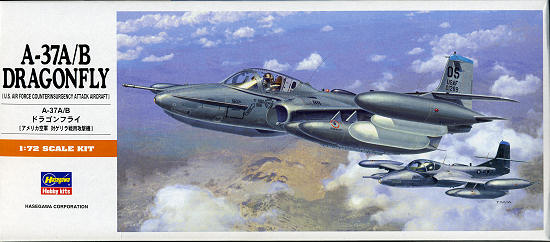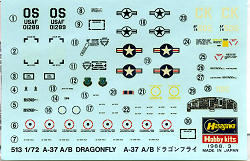
Hasegawa 1/72 A-37 Dragonfly
| KIT #: | 00142 |
| PRICE: | $6.95 on sale from www.greatmodels.com |
| DECALS: | Two Options |
| REVIEWER: | Scott Van Aken |
| NOTES: | 2003 boxing |

| HISTORY |
The growing American military involvement in Vietnam in the early 1960s led to strong interest in counter-insurgency (COIN) aircraft. In late 1962, the U.S. Air Force's Special Air Warfare Center at Eglin Air Force Base's Hurlburt Field in Florida evaluated two T-37Cs for the role.
The Air Force found the T-37 promising, but wanted an improved version of the aircraft that could carry a much larger payload, and had much greater endurance and better short-field performance. This meant a heavier aircraft with more powerful engines. In 1963 the Air Force awarded a contract to Cessna for two prototype YAT-37D aircraft: T-37s with modifications that included:
These changes meant a drastic increase in aircraft weight and the aircraft now had to carry a significant warload as well. Cessna, therefore, doubled the engine power by replacing the two Continental J-69 engines with General Electric J85-J2/5 turbojet engines with 10.7 kN (2,400 lbf) thrust each.
The first YAT-37D flew in October 1964, followed a year later by the second prototype. The second prototype had four stores pylons under each wing, rather than three, and the first prototype was upgraded to this configuration as well.
Test results were good, but USAF interest in counter-insurgency (COIN) aircraft had faded for the moment. The program went into limbo for a time, with the second prototype "put out to pasture" at the National Museum of the United States Air Force at Wright-Patterson Air Force Base in Ohio.
The war in Southeast Asia, however, continued to escalate. Losses of Douglas A-1 Skyraider close-support aircraft in US and South Vietnamese service proved greater than anticipated and USAF interest in COIN aircraft was revived. The YAT-37D seemed like a promising candidate for the job, but the Air Force felt that the only way to be sure was to evaluate the aircraft in combat.
As a result, the USAF issued a contract to Cessna for a preproduction batch of 39 YAT-37Ds, with a few minor changes relative to the prototypes, to be rebuilt from existing T-37Bs. These aircraft were initially designated AT-37D, but the designation was quickly changed to A-37A. The second prototype YAT-37D was pulled out of the Air Force Museum and upgraded to A-37A standards as part of the test program.
The A-37A had a gross takeoff weight of 5,440 kg (12,000 lb), of which 1230 kg (2,700 lb) was warload. The A-37A retained the dual controls of its T-37B ancestor, allowing it to be used as an operational trainer.
In combat "forward air control (FAC)" operations, the second seat was occupied by an observer. Only one crewman normally flew in the aircraft for close support missions, permitting a slight increase in warload.
Several deficiences were found in the A model and corrections were integrated into the all new build A-37B 'Super Tweet'. After the Vietnam war, TAC A-37Bs were provided to the ANG for FAC use and redesignated OA-37B. These were in turn replaced by OA-10As many years later. The A-37B was also supplied to many Central and South American nations where a number of them are still flying today.
| THE KIT |
 This is one of Hasegawa's second generation kits. Still with raised panel line detail, but with thinner plastic and somewhat improved detail. The kit's cockpit is still quite simple with a decal for the instrument panel and only the backs of the seats being provided. One is supposed to use the pilot figures to hide the lack of any meaningful interior and these are glued right to the cockpit floor. There is room in the nose for weight and you'll need it as the gear is pretty short-coupled.
This is one of Hasegawa's second generation kits. Still with raised panel line detail, but with thinner plastic and somewhat improved detail. The kit's cockpit is still quite simple with a decal for the instrument panel and only the backs of the seats being provided. One is supposed to use the pilot figures to hide the lack of any meaningful interior and these are glued right to the cockpit floor. There is room in the nose for weight and you'll need it as the gear is pretty short-coupled.
Landing gear and gear wells are also rather simplified, but at least there is more detail than in the first generation kits. Hasegawa has decided that you want to display a full wing load so has already opened up all the pylon holes for you. You have four large wing fuel tanks and four rocket pods of two different sizes to install. Personally, I'd hit up a weapons set for better looking pods and cut the kit ones from the pylons. The kit has a quite clear, one-piece canopy. Despite the age of the molds, they are in good shape. There are ejector pin marks everywhere, but that is the norm for kits of this age and most will be relatively easy to remove.
 The kit does provided the major differences between the A-37A and A-37B, though it will mean a hole or two will need opened and some areas cut away or filled, but this is all shown in the instructions. Speaking of which, these are pretty typical of what was done in 1988, the date in the instruction sheet. Granted, the kit is from way before then as I built one of these in the late 1970s. Gunze and FS 595 paint references are provided. The two markings options are the box art plane, one of the last USAF OA-37B units, the 19th TASS/51 TFW version in overall FS 36118. This has to be from the date of the instructions as USAF units were all renamed in 1991/92. The other option is one from the original boxing of this kit and is a Vietnam era A-37A from the 604 SOS/3 TFW in the standard SEA paint scheme. Decals are typical old style Hasegawa with off-white white and they are a tad thick. One will need very hot water when applying them.
The kit does provided the major differences between the A-37A and A-37B, though it will mean a hole or two will need opened and some areas cut away or filled, but this is all shown in the instructions. Speaking of which, these are pretty typical of what was done in 1988, the date in the instruction sheet. Granted, the kit is from way before then as I built one of these in the late 1970s. Gunze and FS 595 paint references are provided. The two markings options are the box art plane, one of the last USAF OA-37B units, the 19th TASS/51 TFW version in overall FS 36118. This has to be from the date of the instructions as USAF units were all renamed in 1991/92. The other option is one from the original boxing of this kit and is a Vietnam era A-37A from the 604 SOS/3 TFW in the standard SEA paint scheme. Decals are typical old style Hasegawa with off-white white and they are a tad thick. One will need very hot water when applying them.
| CONCLUSIONS |
OK, so not the best A-37 around and the Academy kit is probably better in all regards, but if one can find this on on the cheap (as did I), it is well worth picking up just to have a nice one for the shelf.
| REFERENCES |
http://en.wikipedia.org/wiki/A-37_Dragonfly
I got this on sale at GreatModels where you can find all sorts of kits and accessories.
If you would like your product reviewed fairly and fairly quickly, please contact the editor or see other details in the